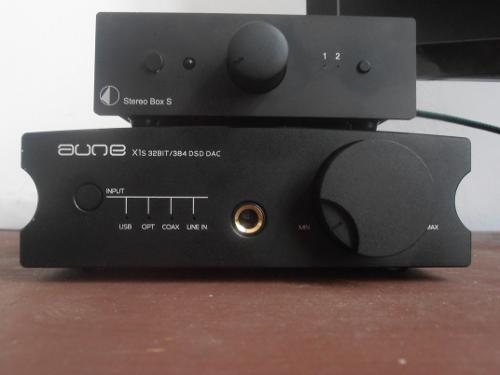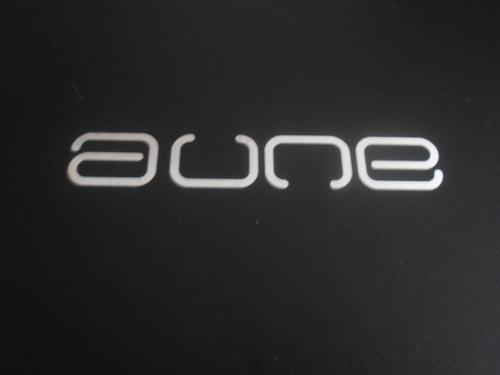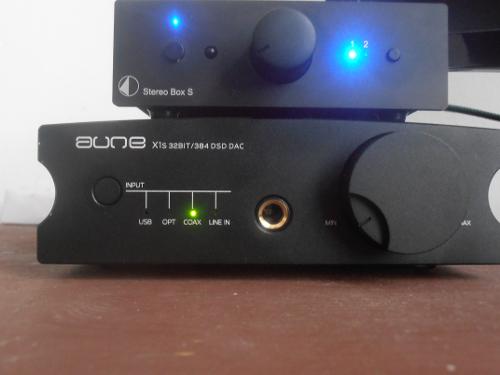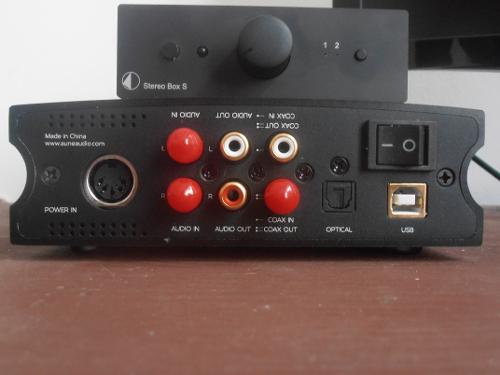
Today i am going to review the new released Aune desktop DAC/AMP: the X1s 10th Anniversary Edition.
This is our first Aune product we review, so would like to share a quick introduction to this company:
“Aune (Wuhan AO LAI ER Technology Co.ltd )company is one of China's first dedicated high-quality digital audio company , it is a development and manufacture of integrated enterprise, with high-end design team unity , excellent operational management team. Full of scientific and technological innovation mission , we are constantly exploring different solutions in the high -quality digital audio field . We are not only the first launched mastering digital audio player in China , launched its supporting 32bit/192kHz advanced decoder and peripheral products , but also supporting the development of personal computers around the traditional audio equipment , developed a high -quality USB decoder and the traditional CD turntable .
In addition to the innovation of R & D , from operations to customer service, from product manufacturing to the user manual , every detail , Aune pursue excellence. We firmly believe that the "pursuit of perfection" is endless . Meanwhile , Aune company's HIFIDIY.NET as the sound field to focus on portal - since 2004 to become the largest Chinese audio site and community , with nearly 1,00,00,00 members. It is the foundation of Aune brand rooted , making Aune brand has extensive influence in the Chinese community , received numerous accolades.
AUNE HISTORY: “aune ”is the brand of the largest Chinese audio technology community HIFIDIY.NET (2004-2014) ,which had ten years of histroy In the past ten years ,we have accumulated a large number of excellent designs. High performance and high quality is aune’s pursuit.
With the new x1 model, Aune wanted to create a simple, easy to use and affordable audio product.
X1s 10th Anniversary Edition is the sixth generation of X1.It is a special version to commemorate the tenth anniversary of the launch of X1. X1 series is a multi-function decoding headphone amplifier which is designed for desktop PC, HIFI and small audio system
X1s 10th Anniversary Edition uses ESS 9018K2M chip (with three filter modes), support for 32bit / 384K and DSD128 master class audio playback, with the next generation of decoding capabilities.
This unit was sent me as a sample unit, I am not affiliated with the company and all observations and opinions will be only my own. Would like to thanks Aune Audio team for sending me this unit giving me the opportunity to test this product.
PRICE: 229 EURO
OFFICIAL SITE : http://mall.auneaudio.com/
FACEBOOK PAGE: https://www.facebook.com/Aune-Audio-145864592691406/?ref=br_rs
PACKAGING: X1s package is quite simple, but well refined and with a good premium feeling. In the black box you will find: the x1s DAC/AMP, Power adapter & cableUSB cable, USB drive with user manual AND 6.35 mm adapter. Build quality is very good for this price range and Aune team made a great job here, giving for sure a premium product with its aluminium chassis( this model was created in conjunction with the European Industrial Design team, featuring an innovative five-sided screw-less design, a minimalist arc of beauty, a blend of technology and art).
In this review I will focus more in the sound quality and synergy with some headphones and IEMs as requested by my readers, cause there a lot of articles that explains quite well its functionalities. Most of the time I used it jus connected in USB mode to my laptop with flac (16,24 bit) and DSD files and for sure it is a well upgrade in sound quality over the internal chip of my Samsung R580 model.

CONFIGURATION WITH SAMSUNG R580 AND WINDOWS 10:
The initial configuration was easy: just plugged the USB port and Windows downloaded the drivers in few seconds. If you will have some drivers problems, you can easily download their latest version from their official site.
Hope they will make a x1 version compatible with the iPhone too, but from what I know, you can connect your Android device to this 10th model.
SOUND: sound is very good for this price range and for sure will be a good upgrade over the internal chip of most laptops over there. Sound signature of this DAC/AMP is quite neutral and revealing with a touch of treble emphasis that will help a lot with warm headphones and IEMs. Bass is quite neutral with good impact, but if you are a bass-head this is not the audio product for you. Sub bass response is quite strong and fast with good impact and decay. Voices are well reproduced, but are more on the clean and natural side than the organic and fuller one. Treble response is a bit emphasized, giving you good definition and airy sound. The new x1s has a natural and clean approach to the music, never sounding too congested or bloated. Dynamic is very good for this price range( obviously can’t compete with premium DAC/AMP over there, but considering its low official price this product makes his great job).
The headphone output power is rated at 200mW @ 300Ω and 560mW @ 32Ω, so is quite good and never had problems with most of the headphones I tested with.
Soundstage is good, but not great, but overall it will give you a high level layering and instrument separation. If you are looking for an “over ear sound experience” this is not a good choice for you. The x1 has a more intimate reproduction, but still, with good separation between voices and instruments in the scene. Soundstage is coherent and is able to reproduce a good amount of air and space between instruments.
Many readers asked me to test this DAC/AMP with some cans and IEMs i already reviewed, so here we are:

HEADPHONE PAIRINGS:
MITCHELL & JOHNSON MJ2: I found this pairing very good. This closed can with electrostatz technology with the x1s has a clean and refined sound. Highs are extremely extended with great definition and details, but never resulting fatiguing or harsh. Voices are well reproduced with excellent realism and detail( voices sound just natural and clean, so do not expect a warm and organic reproduction). Bass response is a bit shy, with a natural and fast sub bass response, so if you are looking for a great and fun bass, most probably this will not a great combo for you.
Dynamic is good with good rhythm and tempo. Soundstage is coherent with good amount of air between instruments and with a good layering.
MEZE 99 NEO/CLASSIC: I found a correct reproduction here, but Meze headphones really shine with amore organic sound. With the x1s, the overall performance is quite clean, but lacks the analogical and organic typical sound of Meze cans. Soundstage is quite big, with a good “over the ear” experience.
AKG K702: the overall sound is clear and analytical, with good excellent voice timbre and tonally. Bass is shy, but well refined and articulated. Highs are a bit thin and, sometimes, can result a bit harsh and fatiguing. Overall, this Aune can drive quite well this headphone, but I truly suggest to use a tube amplifier with AKGk702.

IEMs PAIRINGS:
UNIQUE MELODY ME.1: with this planar IEM, combo is very good: soundstage is big and wide, with the right amount of bass and trebles. X1 can easily drive this IEM( me.1 is a bit hard to drive out of standard DAPs or smartphones, so I truly suggest you to buy a good AMP for this planar IEM).
AROMA AUDIO YAO( 12 BA): the overall sound is very natural with great realism and definition for the voices. X1 helps Yao to have more sparkles on top end and so an airier sound. With its low impedance I found some hiss problems and lack in dynamic range. Nothing you can’t solve with the iFi IEMatch dongle.
If you want to use custom and multi balanced IEMs with the x1s, I truly suggest you to buy this dongle to help with hiss problems and to recover full dynamic range.
INEARZ EUPHORIA CUSTOM FIT(6BA): this combo will give you a full natural sound with very wide soundstage and instrument separation. X1s helps this IEM to have more sparkle on top end and a better treble extension. Due to natural sound signature of this IEM, this combo could result a bit boring for some people. I never notices any hiss issues with this combo.
HEIR AUDIO 10: this is a great combo: bass is strong with great impact and decay, voices are never veiled or lacking details. Treble response is more clean with an airier sound. Soundstage is quite wide with excellent layering. I found some hiss problems her, nothing you can’t solve with the iFi dongle.
CONCLUSION: Overall this new x1s sounds very good for its price range and for sure will be a huge upgrade over the internal chips of most of the laptops over there. Aune created a classy and well built product with a nicely natural and detailed sound( obviously you can find better and fuller sounding DAC/AMP over there, but here the overall performance/price ratio makes this new x1s a clear winner.
PROS: natural and clean sound, good soundstage and layering, output power, build quality
CONS: for some people can sound a bit sterile and not too much engaging
DAC CHIP: ESS 9018K2M chip (with three filter modes), support for 32bit / 384K and DSD128 master class audio playback, with the next generation of decoding capabilities.
Headphone out power: @300Ω 200 mW (0.1% @ 1 KHz 0dB)






![DSC_1314[1].jpg DSC_1314[1].jpg](https://cdn.head-fi.org/a/10060130_thumb.jpg)





















































































































































